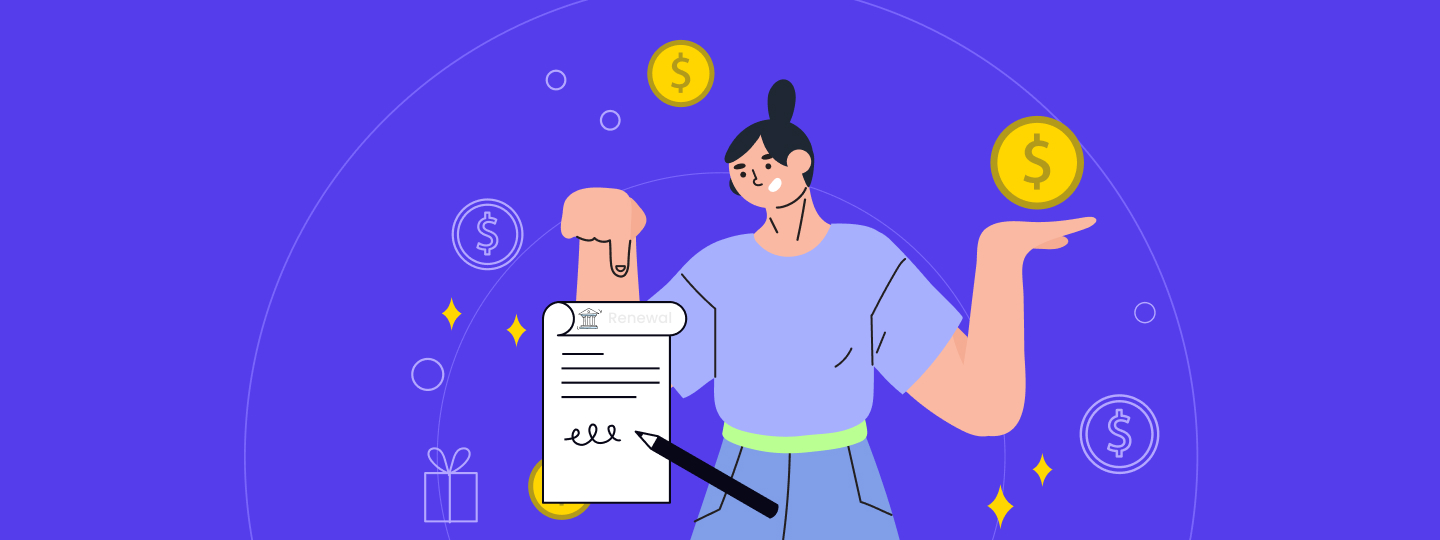Yesterday, while I was on my evening stroll, the caffeine addict in me kicked in and minutes later, I was sitting in Starbucks. I would have kept observing people around me had my eye not caught a glimpse of a little notepad, kept on the chair next to me. I picked it up and looked for the rightful owner. The owner had obviously left by then.
The curiosity got better of me so I turned to the second page, “Marketing Agendas For The Next Quarter”. The marketer in me smiled. It was the feeling you get when you meet a person who speaks your language in a foreign land. At first, I was just searching for the owner’s details in the notepad, now I was searching for meaning in those scribbles.
Over 40% of people make a purchase after receiving a promotional email! It is as if they were waiting and delaying their plans for the email. Data proves that fact is in fact stranger than fiction.
SMSs have moved from being general to personal. Had to! I hated when I used to get an offer to visit Mumbai, almost every week, especially when I was already there. And if you’re catching on the trend, the following fact won’t surprise you.
You know who are the most frequent buyers of these businesses? The people who have a mobile app installed. Well, sometimes data also underscores the obvious.
I moved to the next page
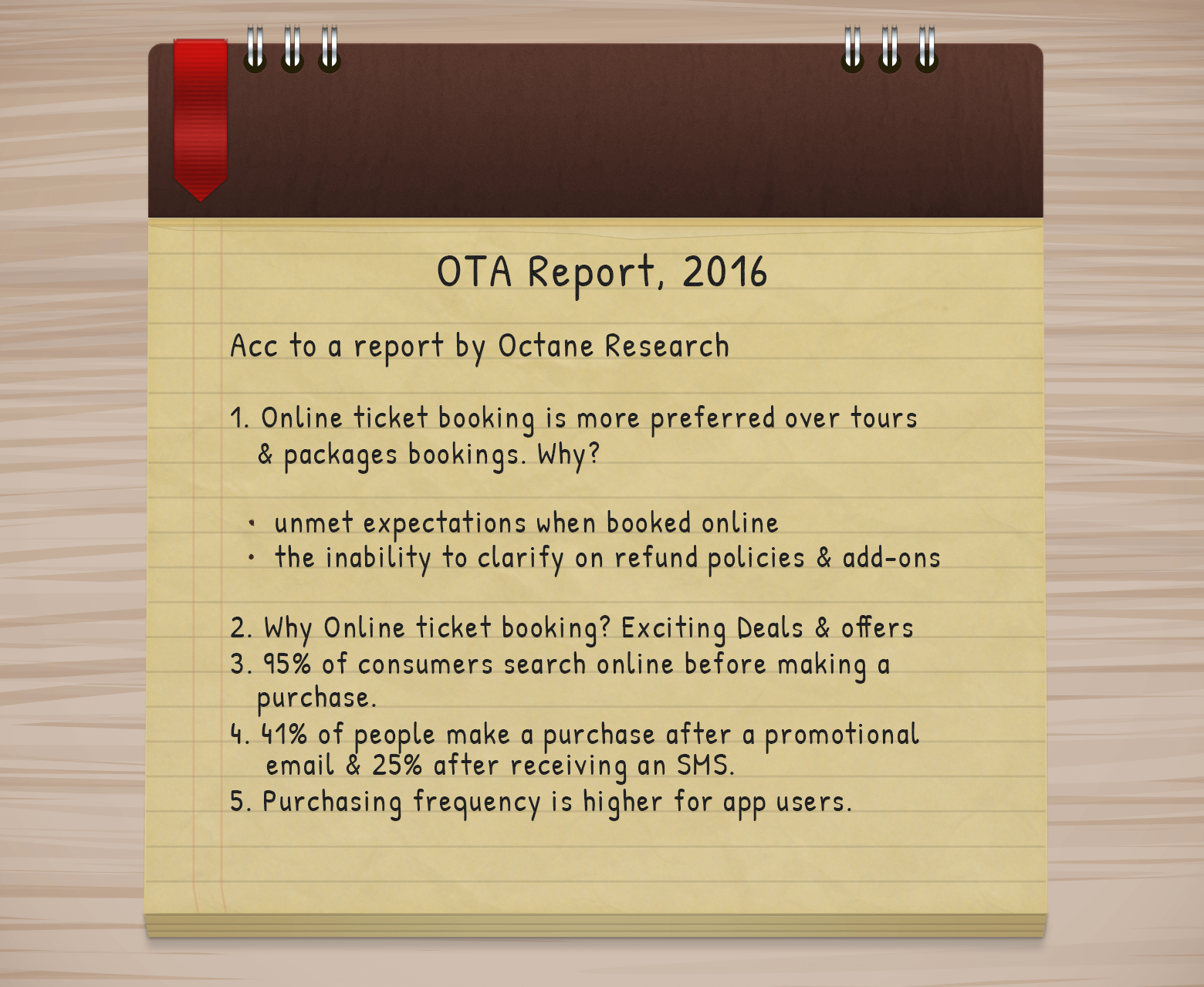
Source- Octane Report, 2016
Online travel agencies- An overview
OTA? Before I would have started guessing, ‘tickets’ and ‘look to book’ ratio stared at me from the notepad. Now I knew it belonged to an Online Travel Marketing guy. Maybe from MakeMyTrip or Yatra or some other big company. Wow! I can find out online travel marketing secrets, right now. Psyched I was, seeing the travel trends.
This one was fascinating. So, evidently no travel site can acquire the market by unidirectional single channel approach. The objective should be to create a coherent, multi-channel customer experience whereby users becomes aware of your brand without becoming overwhelmed by it. Interesting!
I turned to the next page.
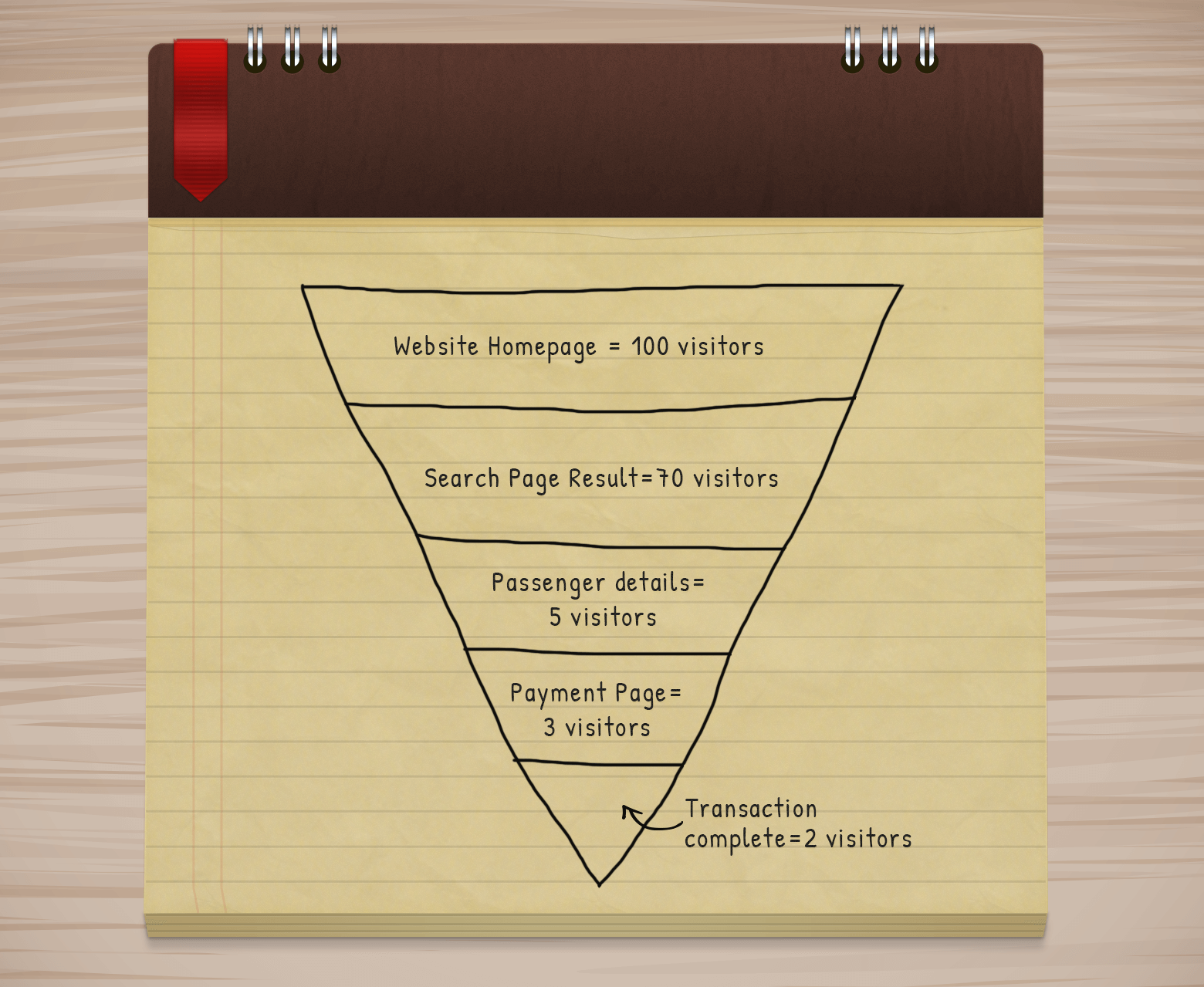
If you see the sales funnel created using the users of this Online Travel Site, for every 100 people that visit your homepage only 70 actually go to a search page result that is only 70 people go and look for something specific and finally in the process of conversion, only 2 out of every 100 become customers.
We can clearly see the attrition rate is high. But there has to be some reason behind these numbers.
And the plot thickens! Did you know while booking a tour or a travel package, a genuinely interested person will typically spend 45 days browsing through 38 portal, 6 months in advance?!
For international flights, the period is around 1-3 months and for domestic flights , it is 2 weeks on an average. The reason is simple, we all love getting the cheapest airline fares.
45 days, 38 portals, so many classes of flights, such huge marketing budgets and at an average only 2 out of 100 people visiting your website, end up buying from you. Wow!
Too much to churn and ponder upon. A glimpse at the next page tells me that, it all makes sense. It all apparently does but the Starbucks guy is calling my name and correctly so. Today must really be my lucky day. My latte-grande is ready. So I guess we all will have to wait for my coffee to finish.
Delving deep into the diary is intriguing, it is opening new avenues to learn tricks of online travel agency marketing. By the way, if you missed on how I got this diary and the first few pages, ah! Not to worry, I have the “statistics related to online travel agencies” right here for you for you.
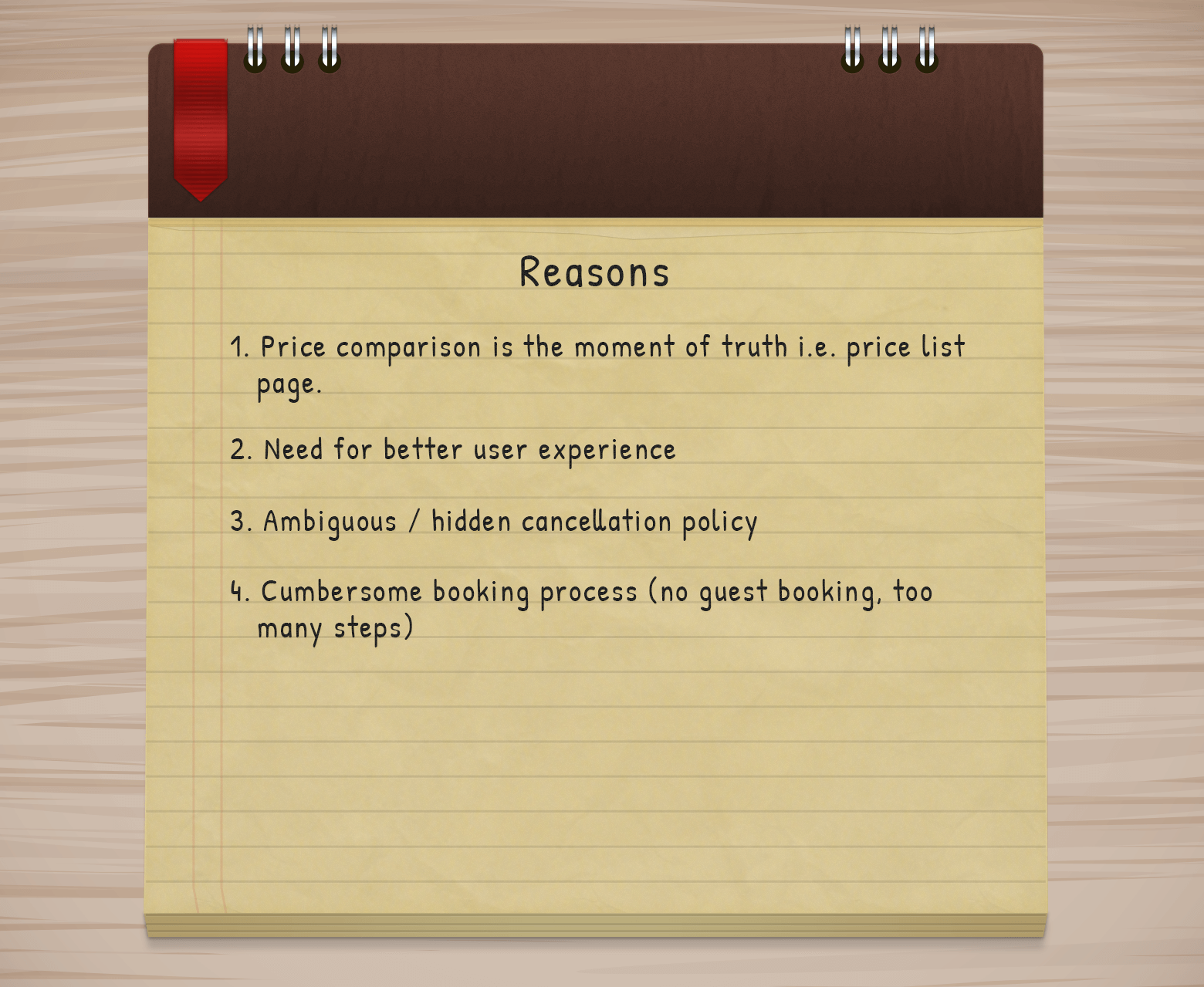
Reasons why churn for online travel agencies is high
- Purchase cycle dilemma
If we think of e-Commerce where the purchases are quicker. You go to a website, like something and eventually if the price is good, you buy it. Basically, the purchase cycle for eCommerce is short. That’s unlikely for travel. You don’t just say that ” Yay! Let’s go to Paris.” You research and read. Also, online bookings are more about attractive offers. Aren’t they? Would you not change from abc.com to xyz.com in a jiffy if xyz.com provided you an additional 20% discount? Of course, you wouldn’t. In shifting from abc.com to xyz.com you are contributing to abc.com’s low ‘look to book ratio’.
- User experience
Personally, for me “Experience” is one important element while I am surfing online. If the site takes too much time to load, I would rather switch to the next tab. Many at times I have personally got really cheap airline tickets but then their ambiguous cancellation policies made me change my mind. Not that I really wanted to cancel my tickets as soon as I booked them online but still clear cancellation policies develop my trust into the platform. - Booking procedure
Finally, the cumbersome booking process. How many times has it happened, when these Online Travel Websites make you fill long forms to book one single flight and that too not once but so many times? - Unavailability of better offers and lack of human intervention
Obviously, there is a fight for Online Travel Agencies to be able to establish their mark, decrease churn and at the same time compete with airline and railway booking websites. I guess unavailability of better offers in Tier 1 and Tier 2 cities due to less frequent flights is also one cause for a higher churn and then comes the lack of human intervention. Usually, when people opt in for tours and packages, they are investing a large amount of money into it, so they usually want a detailed discussion or resource on the following which is backed up by a proper research. At least, when I book a tour, I want someone to explain me every tiny mini detail. After all, It’s my hard earned money. What say?
But this is the problem statement and how I have this love and hate relationship with them. I know what is the problem, how to bring about a change and at least try to effectively reduce attrition.
Can’t think of anything as such, let’s read further.
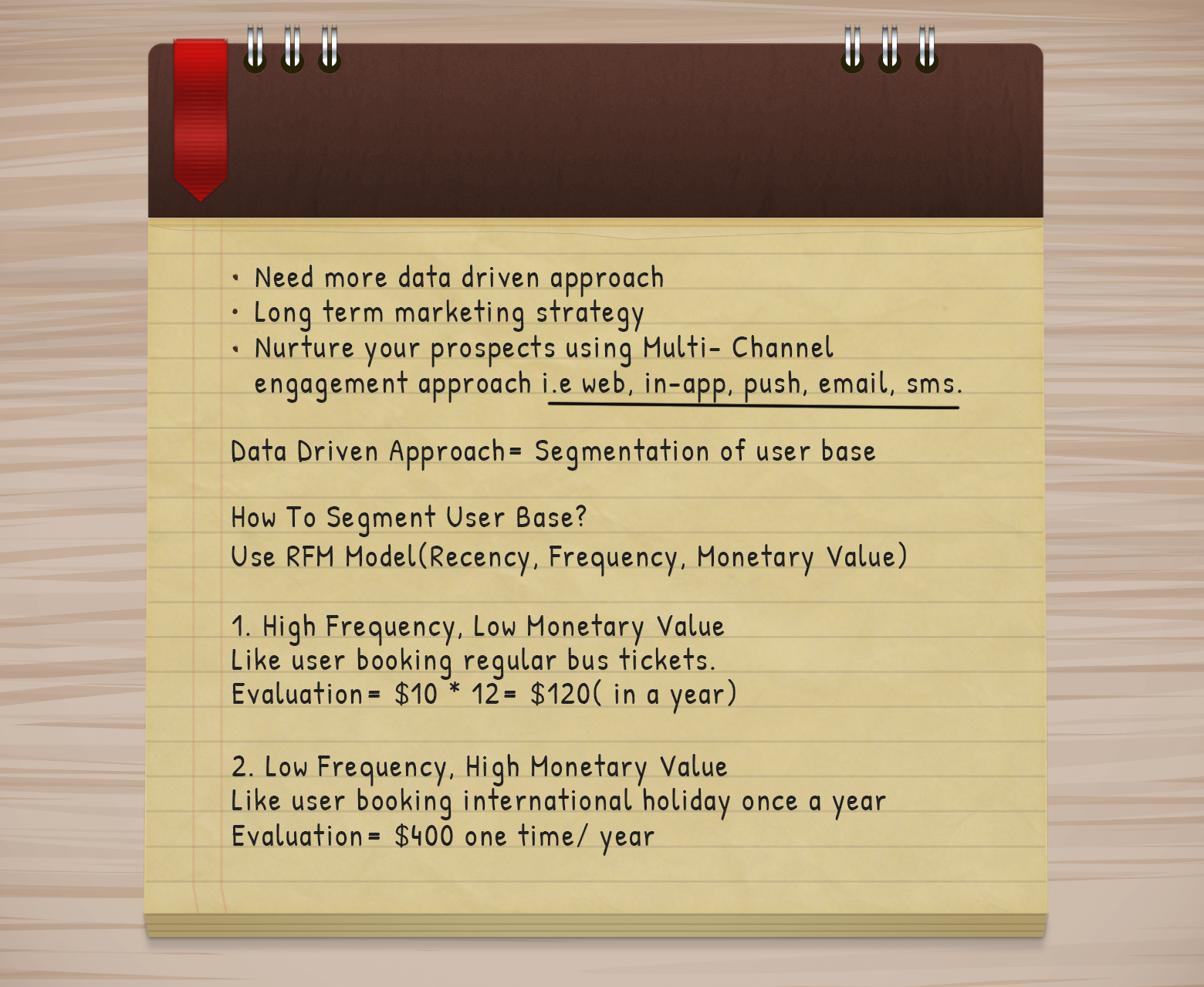
Finally!! Now we are talking. As a marketer, I have always felt this inability to use the existing CRM data to create more meaningful and precise marketing campaign. What is the use of collecting data if it’s not put to good use?
The need of the hour: Data driven marketing strategy for online travel agency
The long term approach of marketing obviously makes more sense for Online Travel Agency Marketing. It is because unlike E-Commerce, travel is a long term purchase and people usually start browsing months before.
I guess why this data has been highlighted is to know the importance of planning your marketing and engagement strategy well in advance to nurture your prospects along their decision-making journey, right from awareness to consideration to purchase, and even beyond (loyalty). Talking about marketing and engagement strategies, spray and pray / batch and blast is a thing of the past. Data-driven marketing is the future, in fact, present.
And with the increase in browsing over various platforms like mobile, tab, app and web, it leaves us no option other than moulding into a multi-channel marketing and engagement passage.
Now, this brings us to the most important question of the hour and that is how to achieve this? Whom to show what? Whom to target and how?
OTA marketing strategy – Using SEGMENTATION!!
Segmentation is all about creating groups of people showcasing similar user behaviour and exhibiting similar actions. Segmentation as a concept makes sense for all businesses alike, but it is more applicable in context of Online Travel Agencies and its marketing strategy.
The marketer has used the RFM model:
R stands for Recency which for an OTA would be when was the last purchase done.
F stands for Frequency which for an OTA would imply that how frequent the purchases
M for the Monetary value of the purchases that were made.
This makes a lot of sense and I’ll tell you why. Calculating the potential of a lead is a mark of a true businessman! What is much obvious becomes oblivious to the eye! Isn’t it common sense that a person who makes a high monetary value investment once a year need not be blasted with monthly deals and a person who has a higher frequency should definitely be pushed towards the loyalty program.
If you see the example quoted of a person who books bus tickets monthly and his yearly evaluation coming to $120 and in contrast a person who invests $400 in a yearly international trip. Now if you sue the same marketing strategies for both, you will be spending more on re-acquiring the bus customer than his total evaluation.
Hence, you cannot have same retargeting strategies for all your users.
Thereby segmentation of users becomes extremely necessary while planning the marketing spend.
Aha! And see that’s how marketers match. The moment I turned the page. My fellow marketer must have been pondering over the same issue. The question was what kind of segmentation do we need?
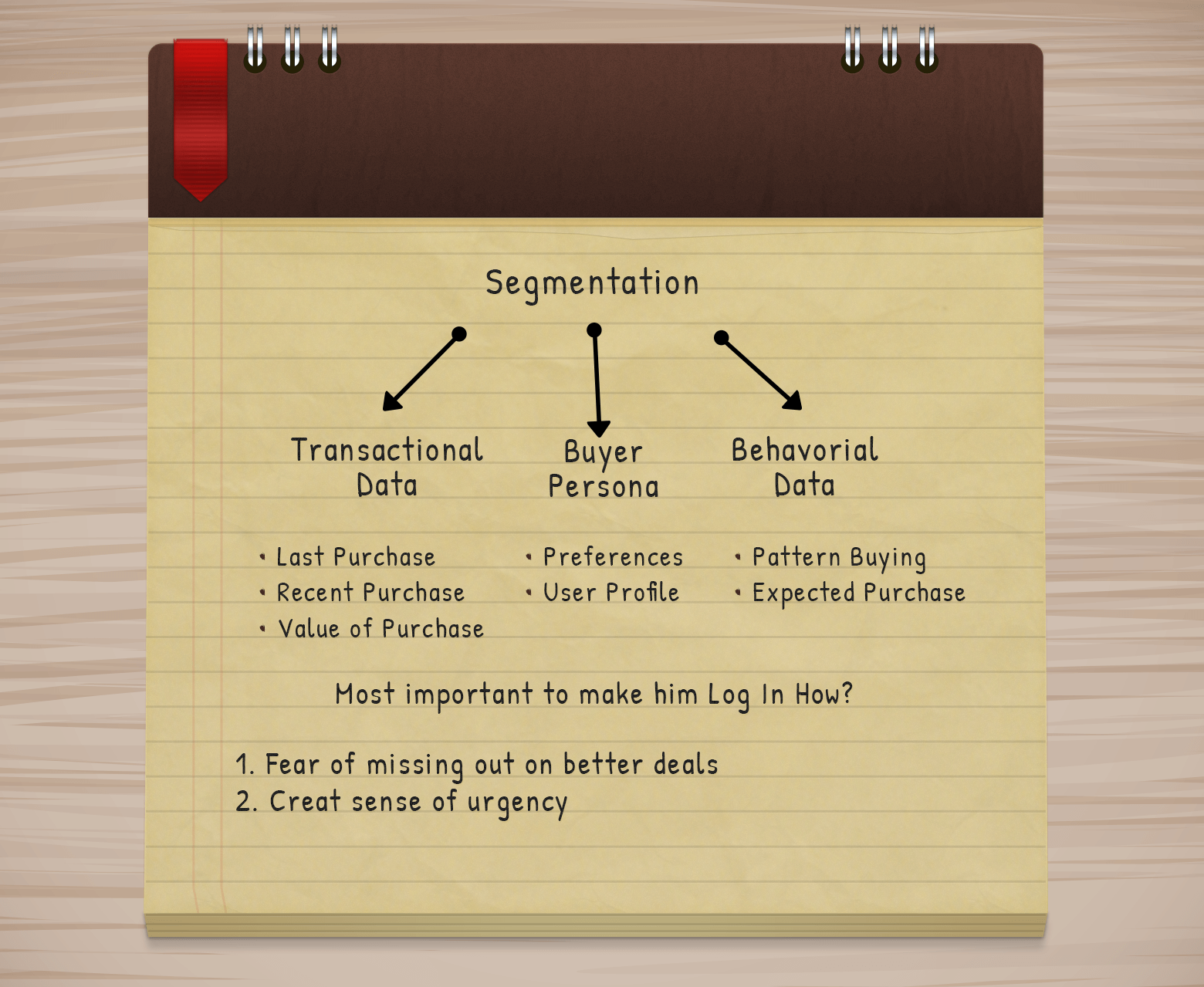
How to segment users for an online travel agency
The demarcation is fair enough according to what I perceive it to be. Basically dividing in majorly into
- Transactional data
- Behavioral data
- Buyer persona
The biggest problem with creating segments comes is keeping a track of transactional data as well as behavioral data.
1. Transactional data
Transactional data can be extracted from our database which majorly revolve around the cost of purchase, quantity and frequency of purchases. It is obvious that those who purchase more need to be pushed towards loyalty program that can be as simple as cash-back to bring back the user to the site and perhaps the users with very low cost of purchase should be pushed to discounts, better deals or the best way out can be combination deals like flight+hotel or return flight.
2. Behavioral data
When we talk about behavioral data, in my experience, let us assume that I search for a flight between New York and Mumbai, Please ignore my wishful thinking! If offered some discounts or on seeing a discount if I move to a better or higher monetary value flight or starts looking for non-stop flights, I am someone for whom user experience matters more than cost, so for people like me, opportunities to cross-sell increases. Please OTA marketers, assume you did not read it and focus more on the part of giving me more discounts. If adding a few hundreds can guarantee me an experience much better than what I was aiming to put my money in, then there can be nothing better than that for me. (Still, I love discounts.)
Also, behavioral data comprises of tracking past searches, frequency of purchases made and creating a persona out of it. The key is to keep collecting data from your users in order to keep adding value to their experience. It’s like if you are a 90s kid, remember getting a slam-book filled from your classmates to know them better and obviously to hear a few good words about yourself.
A short example can sum it up for you; if say a user makes frequent travel between two places near every vacation, you could ask the user if the place tags for a home or workplace and the next time before the holiday arrives, place a personalized message around, “Time to go home/work” with a discount voucher.
Or let us say take another simple example around this, if a person is looking for a holiday package for two, you can always pop a question, if it’s an anniversary or birthday and later reach out to them next year.
3. Buyer persona
I have been pondering over the case of buyer personas for quite some time and I believe it is high time that we delve into understanding who our user is and deliver what they want instead of projecting who we are and what we deliver.
I actually agree that it is very important for the user to log in and the most plausible reason for that has to be to make sense of the user journey. Many at times users search a lot of things while they are not logged in and that data is captured for an anonymous user visiting your website. Tempting them to log in will only enrich their profiles.
I think I’ll need another cup of coffee before I can read any further and I need to dash before the queue gets any longer. I’ll be right back. Till then I shall ponder over how these travel websites market themselves.
Now, what next? We are done with segmenting our users into segments and we know that each segment has to be engaged differently from the other. But that goes more or less on the offers and discounts. What about engaging with users when they are on the website or app? I am sure there are many touch points in a user’s journey where they are more liable to drop out of a website. Aren’t they warm leads if they have spent a considerable amount of time on the website. And come on, so much money is spent in bringing a person to a website, one needs to justify that spent as well.
How to stop them from opting out and converting them into retainable, loyal and advocating customers?
Pre-booking user journey automation
I perhaps did not have to think about it further. As I read along, I saw that my fellow marketer had tried creating an entire lifecycle of a user. And somehow anticipating the actions taken by the user can prove to be extremely beneficial. You’ll know what they desire and you’ll exactly give them what they need. And isn’t it a known fact that when a need meets its fulfillment at the right time, it often results in fruitful results like when you are craving for Pizza, like I always do and dominos just flashes the best offer. I just forget about my health and cave in.
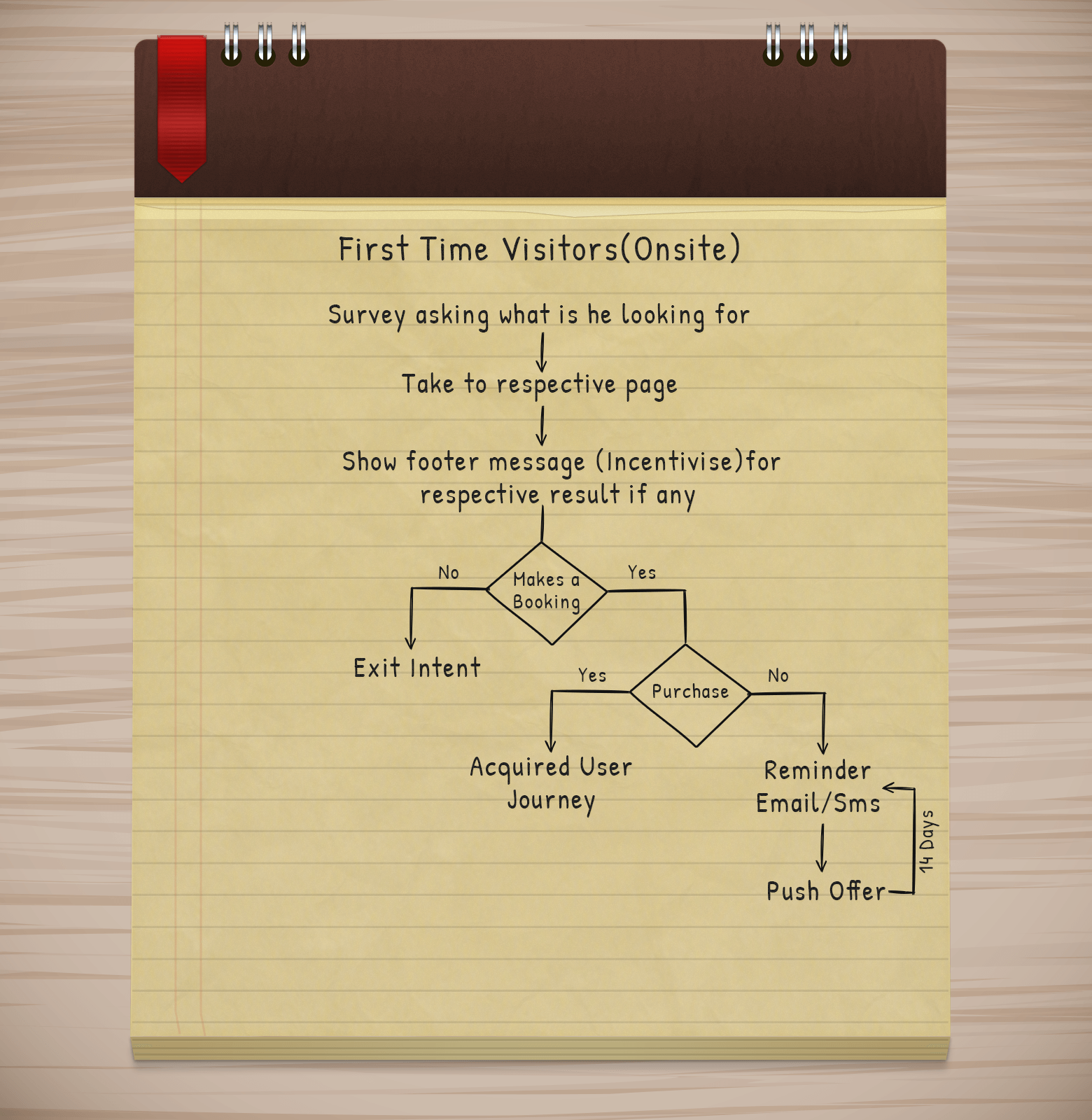
This is one perfect example of gauging the intent of someone who is coming for the first time. This throws me back into the pre eCommerce era. Remember those days when people used to enter shops and there used to be a nagging salesman breathing down your neck. On some days, he would be helpful in showing you the right things and on others you’d want him to disappear. But with internet stepping into the picture, we no more have the need for them but the need of being assisted always stays there and exactly that is where marketing automation is needed.
See, personally, automation is nothing but being ready and reducing human intervention. There are several tools available that let you automate your marketing efforts. Using them you can automate sending emails, text messages, push notifications to your customers. These smart marketing automation softwares let you do user engagement across multiple platforms.
Coming back to the workflow in the image above, a first time user comes and now the first thing is redirecting them to what they’re looking for and then assisting them with relevant offers and information on the screen. Everyone is big time busy these days and making them search for things is bound to get them losing their interest and bouncing off.
What is more important is, getting to know who your user is which is done by either making them log in or getting their information. Also, those who book but forget to make payment or delay payments are extremely warm leads and need to be pushed into being customers.
Likewise, assuming that just acquiring a customer is a battle won is one big mistake. Once the visitor changes to a customer, it becomes extremely necessary that he stays a customer. It is a known fact that it requires 6 times more money to acquire a customer than to retain him. And yet again, the genius our fellow marketer is, he cracked this one as well.
Post-booking user experience automation
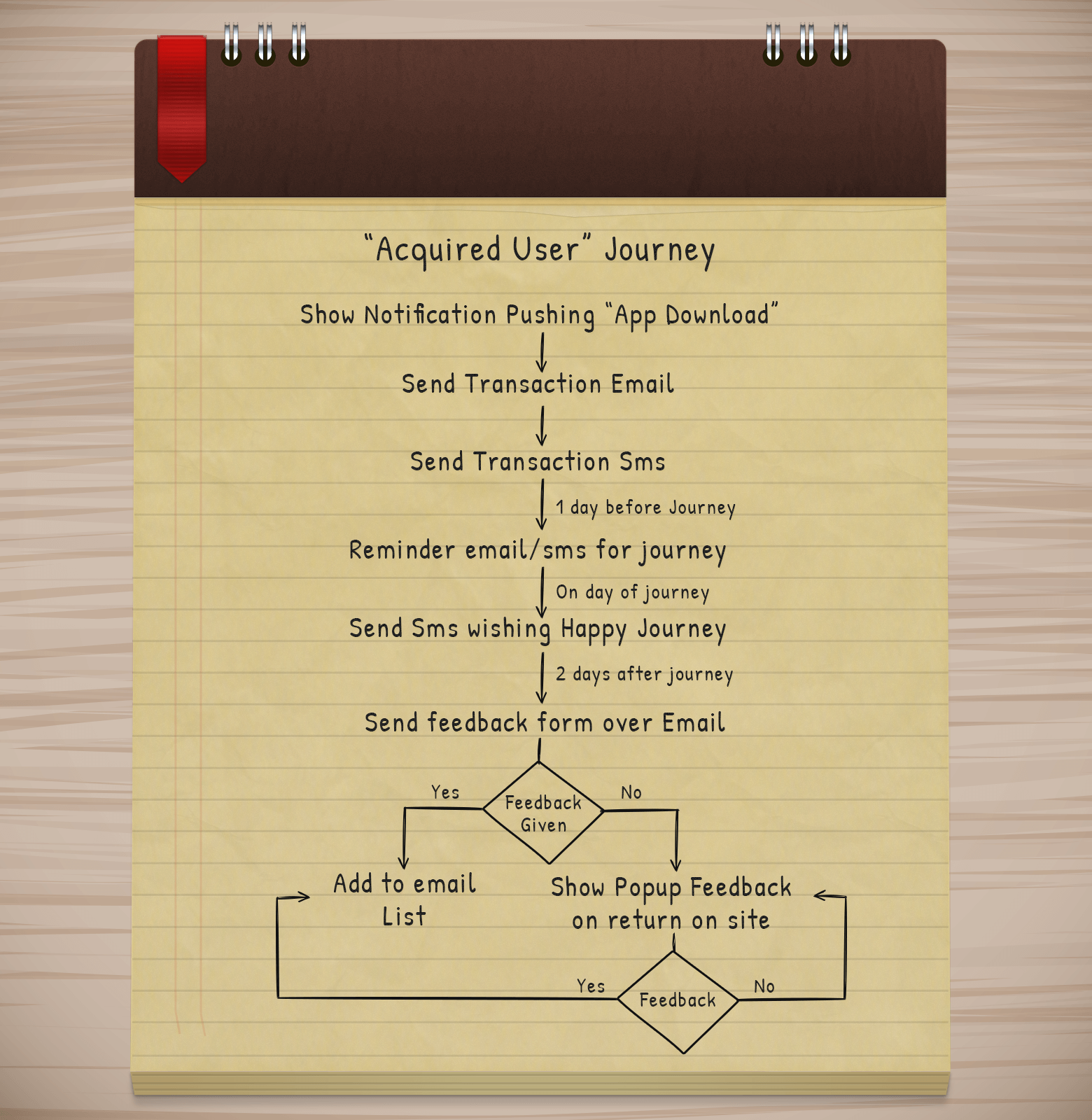
Creating an experience for the user where he feels that he is taken good care of is more than half the battle won! The user needs to be constantly engaged. Once a user has made a purchase, you can start creating user personas. With every purchase, they start revealing a lot about their preferences and they don’t exactly mind sharing relevant information with you around their experience and choices. further more their activities also help you weave together an entire journey for him like shown above.
And the feedback is one great way to know how the experience of the user has been.
And before I could read any further, I saw someone approaching me with a sigh of relief, and voila the mystery marketer is no more a mystery. He turned out to be Animesh Kumar who had been working with Online Travel Agencies for quite a while in his words which turned out to be huge 8 years.
And yes, I asked him for a webinar, and I am glad to tell you that he agreed.

































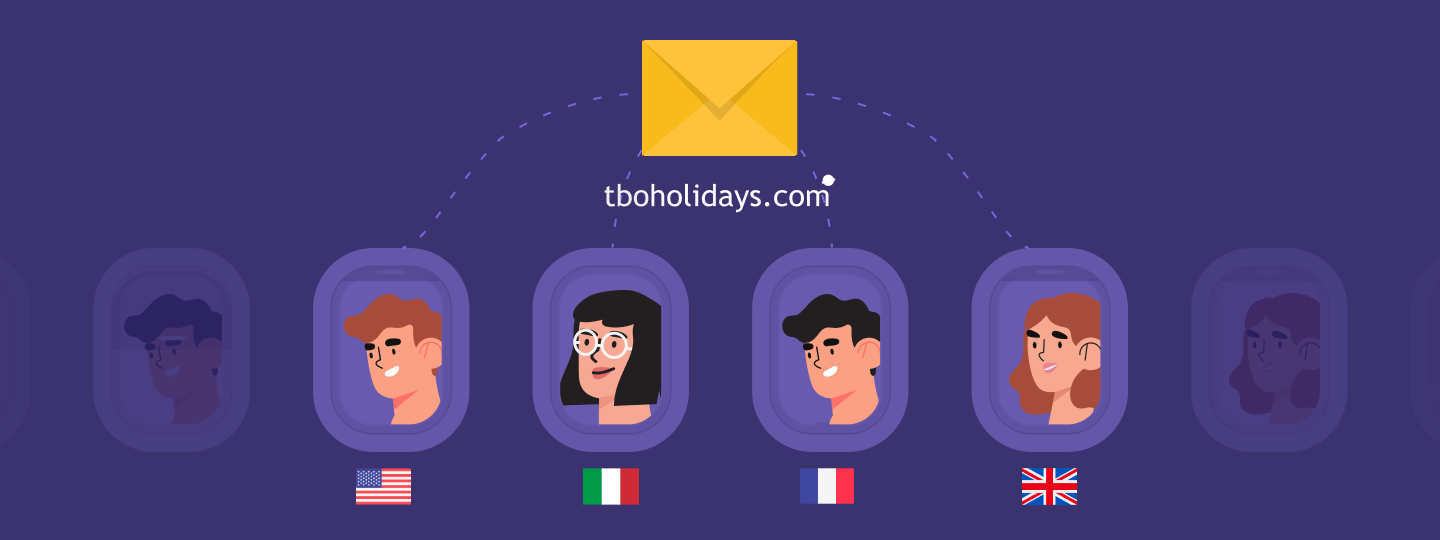
 Dev Iyer
Dev Iyer
 Prakhya Nair
Prakhya Nair